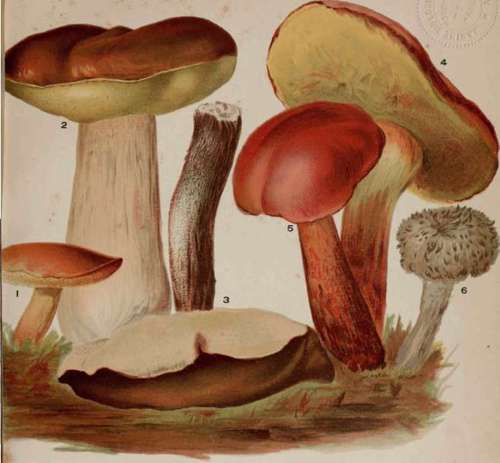Plate VII. Boleti
Description
This section is from the book "Mushrooms Of America, Edible And Poisonous", by Julius A. Palmer. Also available from Amazon: Mushrooms of America, Edible and Poisonous.
Plate VII. Boleti
1. Boletus bovinus.
2. Boletus edulis.
3. Boletus scaber.
4. Boletus sub-tomentosus.
5. Boletus chrysenteron.
6. Boletus strobilaceus.

Description
No. 1. Boletus bovinus. Pileus flat, smooth, viscid; the thin, transparent skin easily peeling. Flesh white, unchangeable in color (stem same color as pileus). Tubes whitish yellow, yellow or gray, shallow. Very variable in size.
No. 2. Boletus edulis. Pileus cushion-like, dry, brown-gray or drab, thick. Flesh white, unchangeable. Tubes white-yellow to green. Stem very thick, often abortive in shape, bulbous at base, very pleasant to taste.
No. 3. Boletus scaber. Pileus bell-shaped at first and hard, then broad, uneven, soft and flat, variable in color from dark-brown to reddish-drab. Stem rough, scabby, fibrous. Flesh dirty white, often changing to black. Tubes white, rusty, often iron-stained in color in spots.
No. 4. Boletus sub-tomentosus. Pileus very variable in form, from bell to cushion shaped; also in color, from light-brown or olive to any shade of red. Stem touched with red, smooth or with light lines, often twisted. Flesh and tubes and stem changing to blue wherever bruised or cut. Tubes yellow, shading at times toward green. Tastes like walnuts.
No. 5. Boletus chrysenteron. Very similar to No. 4, except that the pileus is often brick-red. The flesh is sulphur-yellow and scarcely changeable, and the stem with more red.
No. 6. Boletus strobilaceus. Whole plant blackish, turning red when bruised or cut, broken into thick fir-cone segments or scales. Tubes white or rusty, often enclosed by a veil.
How To Cook
Beat up a batter, or simply some fresh eggs, lay the mushrooms in the same, turning them so as to have the liquid adhere to them. Then fry in hot boiling fat, or on a buttered griddle, according to your liking, with salt and pepper to the taste. Broil, bake or serve under meat as in other recipes here given. Of the above, Nos. 2, 4 and 5 may be stewed, but the others, and, in fact, all Boleti are so moist or viscous that they are much better cooked by dry heat.
N. B. All the above, and many other varieties of esculent Boleti, have tubes colored white, gray, green, or yellow; none are even slightly red.
Continue to:


